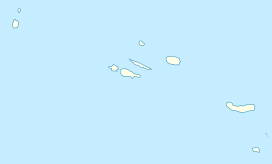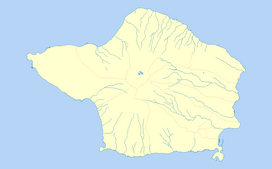Caldeira Volcano
| Caldeira Volcano | |
|---|---|
 Caldeira Volcano seen from space | |
| Highest point | |
| Elevation | 1,043 m (3,422 ft)[1] |
| Coordinates | 38°35′09″N 28°42′53.6″W / 38.58583°N 28.714889°W |
| Geography | |
| Location | Faial Island, Azores |
| Parent range | Mid-Atlantic Ridge |
| Geology | |
| Rock age | 470,000 - 11,000 Years |
| Mountain type | Volcanic crater/Stratovolcano |
| Last eruption | 1958 |
| Climbing | |
| Easiest route | YDS Grade I |
The Caldeira Volcano (Portuguese: Vulcão da Caldeira) is the highest mountain, massive stratovolcano and the largest geomorphological structure that forms the island of Faial. The mountain's highest point, Cabeço Gordo, reaches 1,043 metres (3,422 ft) above sea level. One of the most notable features of this volcano is its two kilometer wide caldera, that is 400 m (1,300 ft) in depth below the crater rim.
History
[edit]
Along the western edge of the Ribeirinha Volcano, the Central Volcanic Complex formed about 410,000 years ago,[2] along with several structures that arose from tectonics. Evidence of this process has not been preserved due to subsidence, but it is generally believed[3] that two formations (an Upper and Lower group) reflecting a geochemical variation that occurred about 16,000 years ago. The Lower group (from 410,000 years ago), was marked by the predominance of a Hawaiian/Strombolian eruptive process, that was composed of basaltic and benmoreitic rocks. The secondary, Upper group, was a highly explosive period (sub-Plinian in character), which produced a series of twelve deposits of pumice and surge deposits (pyroclastic flows of trachytic and benmoreitic).
The volcano was reduced by around 300 m (980 ft) in height due to an eruption that occurred around 1000 years ago. This was one of the last major explosive events recorded in the Azores.[4][5]
Although the central volcano has not been active within the past two centuries, it has seen activity related to the eruption of Capelinhos (1957–58). During this period, fumaroles in the caldera became active, and the minor lakes/swamps were dried-up by excessive heat.
The volcano, due to its central nature, is part of each parish on the island (except for Matriz, Conceição and Angustias).
Geography
[edit]| Caldeira Do Faial Nature Reserve | |
|---|---|
 Panoramic view of the volcano. | |
 | |
| Area | 3.13 km2 (1.21 sq mi)[6] |
| Established | 1972 |
| Governing body | ICNF |
The Caldeira Volcano is the main geomorphological unit, corresponding to a polygenetic volcano two kilometers at the top and one kilometer at the base. The walls of the crater rim are abrupt, although their slopes increase with altitudes. The superficial cover of the volcano is covered in pyroclastic material, such as pumice rock, phreatic and phreatomagmatic deposits, evidence of pyroclastic flows and lahars. The flanks of the stratovolcano also include the Morro de Castelo Branco and peninsula of denser material that have resisted erosion.
References
[edit]- Notes
- ^ "Faial". siaram.azores.gov.pt. Retrieved 8 August 2021.
- ^ Serralheiro et al, 1989
- ^ Pacheco, 2001
- ^ Pimentel, Adriano; Pacheco, José; Self, Stephen (1 May 2015). "The ~1000-years BP explosive eruption of Caldeira Volcano (Faial, Azores): the first stage of incremental caldera formation". Bulletin of Volcanology. 77 (5): 42. Bibcode:2015BVol...77...42P. doi:10.1007/s00445-015-0930-2. ISSN 1432-0819. S2CID 129579466. Retrieved 8 August 2021.
- ^ "Faial (ilha)" (in Portuguese). Enciclopédia Açoriana. Retrieved 8 August 2021.
- ^ "Caldeira Do Faial". Protected Planet. Retrieved 8 August 2021.
- Sources
- "Fayal". Global Volcanism Program. Smithsonian Institution.
- Pacheco, J. (2001), Processos associados ao desenvolvimento de erupções vulcânicas hidromagmáticas na ilha do Faial e sua interpretação numa perspectiva de availação do hazard e minimização do risco [Associated Processes in the Hydromagmatic Eruptions of Volcanoes on the island of Faial and their Interpretation for the Evaluation of Hazards and Minimization of Risk] (in Portuguese), Ponta Delgada, Azores: Departamento de Geociencias, Universidade dos Açores
- Serralheiro, A.; Matos Alves, C.A.; Forjaz, Victor Hugo; Rodrigues, B. (1989), Carta Vulcanológica dos Açores: ilha do Faial à escala 1:15000 [Volcanological Map of the Azores: Island of Faial (Scale: 1:15000)] (in Portuguese), Universidade dos Açores e Centro de Vulcanologia do INIC
- Machado, Adriane; Azevedo, José M. M.; Alemeida, Delia P.M.; Farid Chemale Jr. (2008). "Geochemistry of Volcanic Rocks from Faial Island (Azores)" (PDF). 5, 1. Lisbon: e-Terra, GEOTIC – Sociedade Geológica de Portugal: 1–14. Archived from the original (PDF) on 2011-05-11. Retrieved 2010-08-22.
{{cite journal}}: Cite journal requires|journal=(help)


 French
French Deutsch
Deutsch

